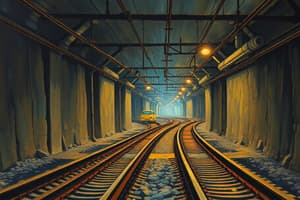Podcast
Questions and Answers
What is the recommended depth for laying main cables parallel to the track?
What is the recommended depth for laying main cables parallel to the track?
What is the purpose of using ducts or pipes while laying cables?
What is the purpose of using ducts or pipes while laying cables?
Why is it desirable to protect cables in rocky areas?
Why is it desirable to protect cables in rocky areas?
What is the minimum distance that should be maintained between cables of other departments and signalling cables?
What is the minimum distance that should be maintained between cables of other departments and signalling cables?
Signup and view all the answers
How should signalling cables be separated from HT power cables?
How should signalling cables be separated from HT power cables?
Signup and view all the answers
What is the purpose of issuing a joint circular by the Civil Engineering, Signalling and Electrical Department?
What is the purpose of issuing a joint circular by the Civil Engineering, Signalling and Electrical Department?
Signup and view all the answers
Why should cables belonging to other departments not be laid in the same trench along with Signal & Telecommunication cables?
Why should cables belonging to other departments not be laid in the same trench along with Signal & Telecommunication cables?
Signup and view all the answers
What should be done to prevent water collection in the duct?
What should be done to prevent water collection in the duct?
Signup and view all the answers
In what order should cables be placed in the same trench, starting from the main track side?
In what order should cables be placed in the same trench, starting from the main track side?
Signup and view all the answers
Why should signalling cables for outdoor circuits not be laid above ground?
Why should signalling cables for outdoor circuits not be laid above ground?
Signup and view all the answers
How should cable supports be spaced when laying cables above ground?
How should cable supports be spaced when laying cables above ground?
Signup and view all the answers
How should indoor signalling cables be laid?
How should indoor signalling cables be laid?
Signup and view all the answers
Why should a minimum distance of 5.5 meters be maintained from the centre of the nearest track when laying cables outside the station section?
Why should a minimum distance of 5.5 meters be maintained from the centre of the nearest track when laying cables outside the station section?
Signup and view all the answers
What should be provided at suitable intervals and at diversion points to mark the route of cables?
What should be provided at suitable intervals and at diversion points to mark the route of cables?
Signup and view all the answers
Why should cables be firmly held with suitable clamping arrangements when entering the Cable room/Relay room/apparatus case?
Why should cables be firmly held with suitable clamping arrangements when entering the Cable room/Relay room/apparatus case?
Signup and view all the answers
What should be avoided when laying cables in a Cable room/Relay room?
What should be avoided when laying cables in a Cable room/Relay room?
Signup and view all the answers
Study Notes
Cable Laying Instructions
- Cables shall be laid generally as per instructions given in this chapter, with special precautions taken in station yards where multiple utilities may exist.
- Cables may be laid underground, either in trenches, ducts, cement troughs, pipes, or any other approved manner.
Cable Depth and Protection
- Main cables laid parallel to the track shall normally be buried at a depth of 1.0 meters from top of cables to ground level, including those laid across the track.
- The depth shall not be less than 0.50 meters for tail cables.
- In theft prone areas, cables may be laid at a depth of 1.2 meters with anchoring at every 10 meters.
- Half Cut DWC-HDPE pipe/RCC or any other approved type of ducts/pipes shall be used to protect the cables.
- Ducts shall be designed and lengthened to prevent/minimize damages to cables by future digging activities in the vicinity.
Cable Separation and Arrangement
- Cables belonging to other departments must not be laid in the same trench along with Signal & Telecommunication cables.
- A distance of approximately 10 cm must be maintained between cables of other departments and signalling cables.
- Signalling cables must be separated from LT power cables by a row of bricks or any other approved means and from HT power cables by a minimum of 3 meters.
Cable Laying Order and Precautions
- Where several cables of different categories have to be laid in the same trench, they shall be placed in the following order, starting from the main track side:
- Telecommunication cable
- Signalling cable
- Power cable
- Signalling cables for outdoor circuits should not normally be laid above ground, but if necessary, precautions should be taken to avoid mechanical damage.
Indoor and Outdoor Cable Laying
- Indoor signalling cables should normally be laid on ladders, channels or in any other approved manner, neatly tied/laced.
- Outdoor cables shall be laid in ducts suitably protected, and in station yards, cables shall be laid in ducts suitably protected.
Studying That Suits You
Use AI to generate personalized quizzes and flashcards to suit your learning preferences.
Description
This quiz covers the guidelines for laying cables in railway stations and yards, including special precautions and approved methods.




